As the world of kayak fishing evolves, motorized kayaks are getting wildly popular. We'll discuss the pros and cons of motor powered kayaks and help you pick the best model for your needs!
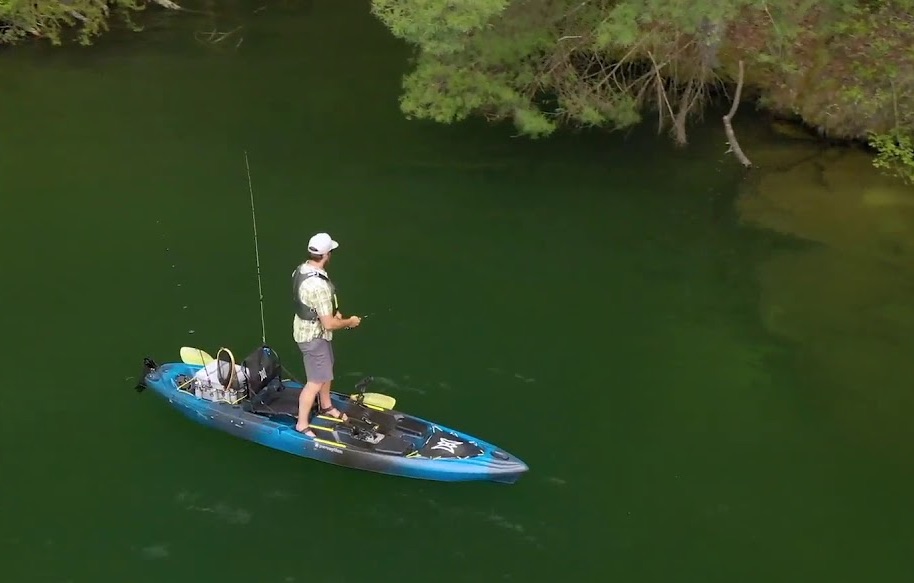
The popularity of pedal kayaks has exploded in the recent years. The ability to go faster with less fatigue and have your hands free to fish, take pictures, or simply hold a drink is hard to pass on.
With so many pedal-driven kayaks on the market today, it’s difficult to choose the one that suits your needs. We’ve reviewed the most interesting models that we consider the best pedal kayaks for 2023.
As an affiliate of Amazon and other retailers, we may earn a small commission when you buy via our links, at no additional cost to you. Thank you!
At a Glance: Best Pedal Drive Kayaks
- Best for the Money: Pelican The Catch 110 HyDryve II
- Best Overall: Hobie Mirage Pro Angler 12 with 360 Drive
- Most Stable: 3 Waters Kayaks Big Fish 108
- Most Portable: Perception Crank 10
- Most Versatile: Vibe Shearwater 125 (with an optional X-Drive pedal drive)
- Most Comfortable Seat: FeelFree Lure 11.5 V2 w / Overdrive
- Best Tandem: Hobie Mirage Compass Duo
- Top Recreational: Hobie Mirage Passport 10.5
- Best Inflatable: Hobie Mirage I11S
- Best for Open Waters: Old Town Sportsman Salty PDL 120
Comparison table: Top Kayaks with Pedals
| Model | Specs | Where To Buy |
 Pelican The Catch 110 HyDryve II | Size: 10’6″ x 34″ Weight: 67 lbs Capacity: 350 lbs | Academy Sports + Outdoors |
Hobie Mirage Pro Angler 12 with 360 Drive | Size: 12′ x 36″ Weight: 132.5 lbs Capacity: 500 lbs | Eco Fishing Shop |
3 Waters Kayaks Big Fish 108 | Size: 11′ x 38″ Weight: 115 lb Capacity: 450 lb | Eco Fishing Shop |
Perception Crank 10 | Size: 10′ x 35″ Weight: 78 lbs Capacity: 350 lbs | Amazon |
Vibe Shearwater 125 | Size: 11’6″ x 34″ Weight: 87 lbs Capacity: 425 lbs | Amazon |
FeelFree Lure 11.5 V2 w / Overdrive | Size: 11’6″ x 34″ Weight: 87 lbs Capacity: 425 lbs | Eco Fishing Shop |
Hobie Mirage Compass Duo | Size: 13’6″ x 35″ Weight: 127 lbs Capacity: 475 lbs | Eco Fishing Shop |
Hobie Mirage Passport 10.5 | Size: 10’5” x 34” Weight: 75 lbs Capacity: 325 lbs | Eco Fishing Shop |
 Hobie Mirage I11S | Size: 11’3″ x 39″ Weight: 64.5 lbs Capacity: 400 lbs | Amazon |
Old Town Sportsman Salty PDL 120 | Size: 12′ x 34.5″ Weight: 85 lbs Capacity: 450 lbs | Amazon |
15 Top Kayaks with Pedals Reviewed and Rated
Best for the Money: Pelican The Catch 110 HyDryve II
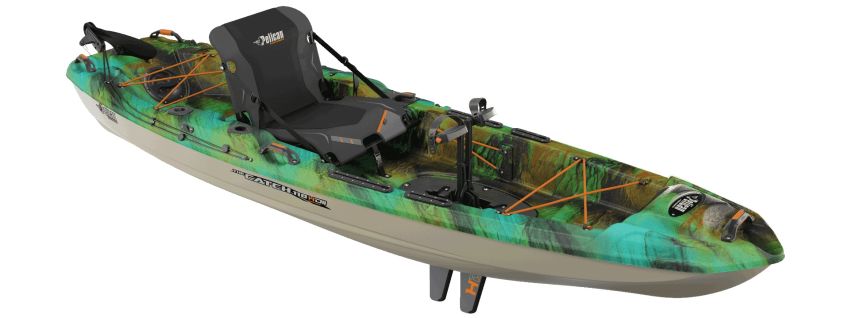
Length: 10’6″ (320 cm)
Width: 34″ (86 cm)
Weight: 67 lb (30.4 kg)
Capacity: 350 lb (159 kg)
Back in 2020, Pelican came up with an option for budget-minded users who still want to enjoy the advantages of a hands-free kayaking experience. To this day, the Pelican The Catch 110 HyDryve II one of the least expensive pedal powered kayaks on the market.
At only 67 lbs (30 kg), the Catch 110 is the second lightest model on our list. It is also one of the more compact models we’ve tested at just 10’6” (320 cm) in length.
Many users report that this kayak is surprisingly maneuverable and functions really well for small to average-sized paddlers. It comes with a Hobie-style, fin-based pedal drive (HyDryve II) with push pedals, a comfortable adjustable seat, three built in rod holders, and spacious tank wells on the bow and the stern.
Note that unlike most propeller based pedal drives, the Hydryve does not have reverse, so it can only move the kayak forward. This is a significant limitation, especially when you fish in tight spaces and need to back up in a rush. But at this price point, it’s hard to complain.
Also, due to its somewhat limited weight capacity of just 350 lb (159 kg), the Catch 110 HyDryve II isn’t the best option for larger-sized individuals or those who like to bring a lot of fishing gear. If that’s you, consider the larger model, The Catch 130.
Anyway, this model is a solid choice for anyone looking to own a pedal fishing kayak that won’t break the bank.
Pros:
- Compact
- Lightweight
- Affordable
Cons:
- Lacks stability
- Limited weight capacity
Best Fishing Kayak with Pedals: Hobie Mirage Pro Angler 12 with 360 Drive

Length: 12′ (366 cm)
Width: 36″ (91 cm)
Weight: 132.5 lb (60.1 kg)
Capacity: 500 lb (227 kg)
For anglers who are seeking the best possible option when it comes to pedal fishing kayaks, it’s hard to beat the Hobie Mirage Pro Angler 12 with 360 Drive. This kayak is feature-rich and delivers on the legendary performance level that Hobie is known for. The Hobie Mirage Pro Angler 12’s ergonomic design is evidence that Hobie engineers thought of every possible convenience related to how this kayak would perform on the water.
The MirageDrive 360 is arguably one of the best pedal systems ever made. It allows users to turn on a dime and pick up incredible amounts of speed with just a few steps on the pedals. Kayak anglers will also appreciate the kick-up fins and rudder that are built to retract upon impacting a solid object beneath the water’s surface.
There is no shortage of storage options both dry and open. With two flush mount rod holders, horizontal rod storage with rod tip protection, and plenty of tackle space under the Vantage ST seat, it’s easy to see why we consider this one to be the best pedal drive fishing kayaks on the market.
Pros:
- MirageDrive 360
- Great stability and comfort
- Plenty of storage
- Kick-up fins and rudder
Cons:
- Expensive
- Heavy
Most Stable: 3 Waters Kayaks Big Fish 108
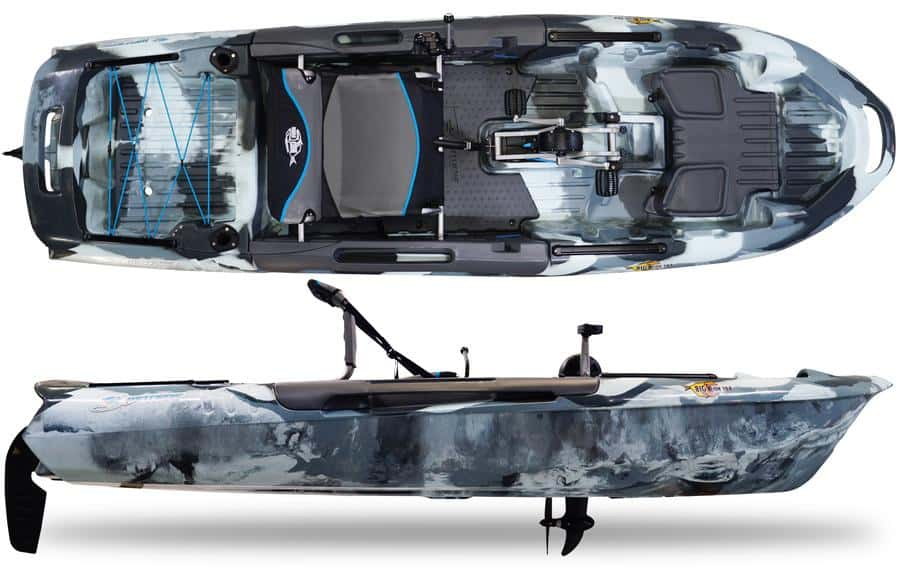
Length: 11′ (335 cm)
Width: 38″ (96.5 cm)
Weight: 115 lb (52.2 kg)
Capacity: 450 lb (204 kg)
3 Waters Kayaks made quite a splash in the kayak industry in recent years after designing new models that were a bit more budget-friendly than the competition, yet still delivered on some of the most important performance characteristics users look for.
The 3 Waters Kayaks Big Fish 108 features the brand’s signature cathedral hull design that provides rock-solid stability in a wide range of water conditions. The Big Fish 108 is usually available for less than $2,000, which makes it an affordable fishing platform when compared to other premium pedal kayak models.
This sit on top fishing kayak offers plenty of features that any angler will appreciate. The Pro Fish Pedal Drive system operates using a chain which gives the propeller more torque and translates to greater power on the water. You also get instant reverse.
There’s a retractable transducer mount that allows users to lift the sonar out of the water when they’re preparing to launch. The seat is made with padded, breathable mesh and can be adjusted to suit the user’s preference. A huge tank well offers ample space for your fishing gear.
Being one of the widest kayaks on our list, the Big Fish 108 isn’t very fast. But many anglers will happily pay that price for such an incredibly stable fishing platform. Read full review.
- Incredibly stable
- Transducer ready
- Affordable price
Cons:
- Lacks speed
Most Portable: Perception Crank 10

Length: 10′ (304 cm)
Width: 35″ (89 cm)
Weight: 78 lbs (35 kg)
Capacity: 350 lbs (159 kg)
Perception’s Crank 10 is widely known for being fun, comfortable, and easy-to-use compared to other pedal drive kayaks. With a compact and lightweight design, the Crank 10 offers plenty of storage space and is ideal for recreational use in calm lakes and reservoirs. It does lack some features that users might look for in regard to fishing, but there are plenty of reasons why this is among the top pedal kayaks on the market for 2023.
This kayak is super compact at only 10’ (304 cm) in length, which means it should be no problem to load and unload and get into the water. The seat and its positioning on the Crank 10 are said to be among the most comfortable on the market. The pedal system utilizes a propeller and operates in the same way a bicycle would, which allows users to have a more natural motion and cover more ground with their legs. The Crank 10 is said to be highly agile and is the perfect blend of fun and comfort.
Pros:
- Compact
- Lightweight
- Comfortable
Cons:
- Not ideal for fishing
- Not suited for rough water
Most Versatile: Vibe Shearwater 125 (with an optional X-Drive pedal drive)

Length: 11’6″ (350.5 cm)
Width: 34″ (86.4 cm)
Weight: 87 lb (39.5 kg)
Capacity: 425 lb (192.8 kg)
Vibe is well-known for its ability to produce kayaks that deliver on performance and capability at a price that’s a bit more budget-friendly. The Vibe Shearwater 125 is another great option in that same regard as it features a smooth and speedy pedal system and can be purchased for well under $2,000 in many cases.
Users have the option to customize many different parts of the Vibe Shearwater 125 and there are a number of premium fishing features that are especially useful for serious anglers. The seat is adjustable, but some users say that it lacks the amount of padding one might look for in a high-quality pedal kayak.
Pros:
- Stable
- Great speed
- Dry storage
Cons:
- Limited range in shallow water
Most Comfortable Seat: FeelFree Lure 11.5 V2 w / Overdrive

Length: 11’6″ (350.5 cm)
Width: 34″ (86.4 cm)
Weight: 87 lb (39.5 kg)
Capacity: 425 lb (192.8 kg)
The FeelFree Lure 11.5 V2 with Overdrive is designed to be all about an easier experience on the water. It lets users focus on finding and catching fish instead of being burdened with paddling across great distances. This kayak has one of the most efficient pedal systems on the market. But better yet, it can also be fitted with FeelFree’s Motordrive package that totally eliminates the need for physical exertion to get where you want to go on the water. The Overdrive pedal system is exceptionally smooth and provides superior speed and efficiency when compared to other pedal kayak drive systems.
The FeelFree Lure 11.5 V2 w / Overdrive is known for its high-quality features which include a removable electronic and sonar pod. This means anglers can install the fish-finder of their choice without having to make any frustrating changes to their boat. The kayak’s extra-wide Gravity seat is said to be among the most comfortable on the market and can be adjusted to make sure each user gets just the right position for their liking.
Pros:
- Removable electronics pod
- Highly comfortable seat
- Great stability
Cons:
- Heavier than some other models
Best Tandem: Hobie Mirage Compass Duo

Length: 13’6″ (411 cm)
Width: 35″ (88.9 cm)
Weight: 127 lb (57.6 kg)
Capacity: 475 lb (215 kg)
Finding a tandem pedal drive kayak that is a good blend of performance and comfort is not easy, but the Hobie Mirage Compass Duo provides just what many users are looking for in a capable fishing kayak that’s built for two. This kayak offers all the great features that Hobie’s new models are known for without the usual compromises that come with a tandem kayak.
Users will appreciate the Compass Duo’s ability to convert to a single-user kayak, as well as the many features that give anglers everything they need to enjoy their day on the water. This kayak is surprisingly nimble for a large, two-person model and perfect for users who like to share their kayaking experience with others.
Pros:
- Highly versatile
- Comfortable seating
- Kick-up fins
Cons:
- Expensive
Top Recreational: Hobie Mirage Passport 10.5

Length: 10’5” (317.5 cm)
Width: 34” (86.3 cm)
Weight: 75 lbs (34 kg)
Capacity: 325 lbs (147.4 kg)
The Hobie Mirage Passport 10.5 is roughly the same size and weight as the Pelican model in our No. 1 spot, but this model offers an overall greater level of quality when compared to other compact pedal kayak models. While the Mirage Passport 10.5 doesn’t offer much in the form of fishing features, it does serve as an exceptional kayak for simple recreational use.
This kayak is made according to the same high standards that Hobie is known for and provides enough storage for a single-day trip, or even an overnight journey for the most dedicated kayaking enthusiasts. Everything on this kayak is designed to be fun and easy-to-use. The Hobie Mirage Passport 10.5 offers the brand’s famous Mirage Classic drive system which makes pedaling your kayak across great distances a breeze.
Pros:
- Lightweight
- Compact
- Dry storage
- Stackable design
Cons:
- Limited storage
Best Pedal Powered Inflatable: Hobie Mirage I11S
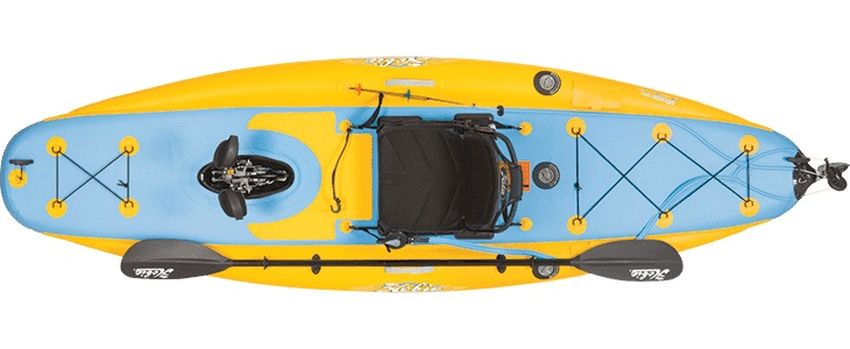
Length: 11’3″ (340 cm)
Width: 39″ (100 cm)
Weight: 64.5 lb (29.3 kg)
Capacity: 400 lb (181.4 kg)
Having an inflatable kayak is a huge advantage in allowing anglers to venture just about anywhere with their vessel without having to deal with a cumbersome frame and weight of a traditional kayak. The Hobie Mirage I11S adds to that level of convenience by offering the advantage of a pedal system. This kayak is made with a low-profile design, as well as a rigid hull that provides solid durability on the water.
The Hobie Mirage I11S offers an outstanding level of portability as it is super lightweight and comes with a rolling travel case. It also features Hobie’s standard seat that is one of the most comfortable seats in the kayak industry. This kayak might lack some of the storage options and other features typically found in a premium fishing kayak, but for users who want the ease of an inflatable kayak coupled with the advantages of using a pedal system, there’s no better option than the Hobie Mirage I11S.
Pros:
- Highly portable
- Durable material
- Easy to pack and assemble
Cons:
- Lacks storage space
- Fewer features than other kayaks
Best for Open Waters: Old Town Sportsman Salty PDL 120

Length: 12′ (370 cm)
Width: 34.5″ (87.6 cm)
Weight: 85 lb (38.5 kg)
Capacity: 450 lb (204 kg)
Freshwater fishing kayaks are not quite able to withstand the sometimes choppy conditions that anglers find in and around coastal areas. Old Town designed a kayak that’s right at home in the salty swells with the Sportsman Salty PDL 120. The V-shaped hull design is made to cut through the waves and the build is made to provide users with enough stability to stand and fish when they choose. This pedal kayak is reliable and easy-to-use in both saltwater scenarios, as well as anywhere else you want to fish.
The Sportsman Salty PDL 120’s seat design is exceptionally comfortable and gives users plenty of lower lumbar support along with a breathable mesh material that’s able to dry more quickly and handle the ocean spray that typically comes with coastal kayak fishing. This kayak has more than enough features to satisfy the average angler and offers a super-smooth pedal propellor system.
Pros:
- Comfortable seating
- Transducer ready
- Good stability
Cons:
- Lacks dry storage
- Somewhat limited capacity
Choosing a Pedal Kayak for Fishing and Recreation: Things to Consider
Pedal kayaks are able to offer much of the same performance benefits as a paddle kayak, yet many brands are finding new ways to deliver on propulsion mechanisms to make the pedaling experience more efficient for kayak anglers, as well as recreational users.
Being able to move a kayak with your feet opens up a plethora of possibilities for kayak anglers as they now can have their hands free to make a cast, or continue fishing while they pedal past an area. This new ability is a revolutionary tactic in competitive kayak fishing as it allows users to cover a considerably greater distance than before while fishing more than ever.
RELATED: Think that even pedalling may be too much of a workout for you? Check out our roundup of the best kayaks with motors.
Benefits of a Pedal-Driven Kayak
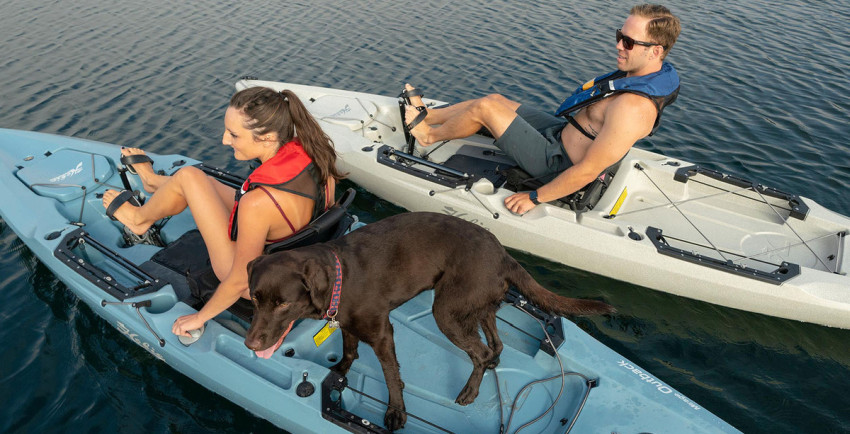
Speed
For competitive kayak fishing, speed can sometimes be a deciding factor that gives an angler the slightest edge over his competition. Speed can become a major factor in the ability to win a championship. As anyone who’s ever been kayak fishing knows, paddling a kayak across a large lake or reservoir is quite a bit of work, especially if you’re short on time and need to get to a new location quickly.
New pedal kayak models are helping anglers reach greater speeds with even less effort than before. This not only helps anglers cut down on the amount of time they spend chugging through the water, burning their arms and upper body muscles up as they paddle toward a destination. Now, they can sit back, steer their vessel toward their chosen waypoint and let their legs—the strongest part of their body—do most of the work to get them where they need to go.
Advanced models in pedal kayaks now allow users to reach greater speeds while also helping them achieve more consistent speeds than ever before.
Free hands for fishing
One of the age old issues with kayak fishing has always been swapping back and forth from your paddle to your fishing rod in a seemingly endless cycle of arriving at a good spot, putting the paddle down in a secure fashion and switching to your fishing rod, only to do the same thing every single time you go to a new location.
Being able to propel your kayak using a pedal system means you’ll keep more of your focus on the area you’re fishing. Sometimes it can be more productive to simply make a few casts as you pass through an area in an attempt to cover a larger swath of water than having to stop, switch from paddle to rod and throw a few casts. Pedal kayaks have proven to be a real game changer that allows anglers to make more casts in one fishing trip than they would in using a paddle kayak.
Less Fatigue
Our legs are designed to work more efficiently with greater strength and longer endurance than our upper bodies. Using a pedal kayak takes advantage of our body’s natural movement and dynamics as our legs can propel us longer distances across the water than we ever could achieve with a paddle. This all equals out to anglers being less fatigued on the water, which helps them stay sharp and focused on what they need to do in order to catch fish more efficiently.
Easier to use
As any kayak angler knows, one does not simply sit in a kayak and begin to paddle like a professional right out of the gate. It takes time and practice to learn the proper technique in body position and movement in order to paddle in a way that will allow you to gain more speed and distance than merely chopping away at the water surface.
Kayak pedaling is just like walking. With newly developed pedal kayaks, a user can use their legs in an intuitive manner to get their kayak moving and maintain a steady speed, regardless of the amount of chop on the water.
Drier Ride
It doesn’t take many fishing trips in a kayak to learn that paddling a kayak will result in a user getting wet, often soaked in some cases, due to the water dripping down the kayak and onto the user’s lap and everywhere else. On colder days, this extra wetness can be especially undesirable as it takes longer to dry and leads to anglers getting cold faster than they normally would if they were dry.
Kayak pedaling doesn’t require the use of a paddle, and therefore, results in less splashing and dripping from the paddle. Simply put, you’ll stay much more dry in a pedal kayak than you would using a paddle.
Disadvantages of a Pedal-Propelled Kayak
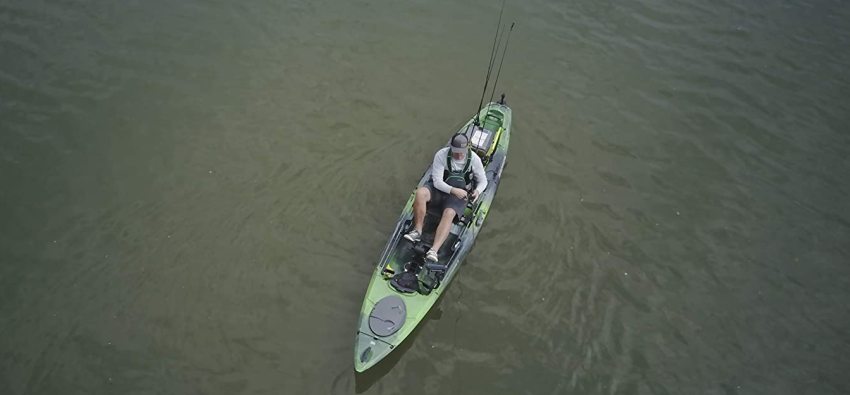
Weight
Despite so many great advantages to pedal kayaks, there are some disadvantages that must be taken into account if one were to take a truly objective approach to determining whether a pedal or paddle kayak is best for them.
Pedal kayaks tend to weigh more than their paddle-driven counterparts, meaning you’ll be able to fit less gear onto your vessel before reaching full capacity and it will be much harder to cartop or transport as you’ll be forced to find a space to fit the pedal system, which can usually be removed and stored separately from the kayak.
This increased weight will likely mean you’ll need to acquire a cart or trailer to properly transport a pedal-propelled kayak. This is another expense that must be taken into account for a kayak that’s already more pricey than its older predecessor.
Cost
It’s no secret that pedal-propelled kayaks can be much more expensive than paddle-driven models. The extra work that it takes to design the pedal system and other components must be taken into account by the manufacturer and a price increase on these kinds of kayaks is to be expected in any case.
It’s important to carefully examine all of the benefits and disadvantages of a pedal-propelled kayak in order to determine whether or not it’s worth investing the extra amount of money into. For most casual kayak anglers, spending another thousand dollars on a better model isn’t always a viable option.
Performance in Shallow Water
One clear advantage a paddle kayak will have over any pedal-propelled model is the ability to travel into shallow water, sometimes less than a couple feet. Pedal kayaks will typically sit lower in the water as they are heavier, but the real vulnerability when using them in shallow water is the pedal fins or other devices that protrude a few inches or a foot below the bottom of the kayak.
In many cases, the pedal system can be susceptible to being entangled in weeds and other objects that are commonly found just beneath the water’s surface. If you plan to fish “skinny water” and areas where it is an absolute necessity to travel across water that’s a couple of feet deep, it is important to consider using a paddle kayak. However, there are some newer pedal-propelled models which users can easily remove the pedal system and utilize a paddle in the event that they encounter shallow water or dangerous underwater structures that might damage their pedal system.
Reliability
More things to break. Can be important on multi-day trips
One of the great characteristics of paddle kayaks is their overall simplicity. Anglers know just what it takes to keep their kayak going and can plan accordingly to have a replacement paddle, extra plug, or other gear item that will allow them to keep going if something does happen to break or malfunction.
This isn’t always the case with pedal-driven kayaks. The more complex pedal systems are vulnerable to being damaged or broken, especially if you are using your kayak in lakes or rivers with lots of large rocks, logs, stumps, and other objects that pose a serious threat to your pedal kayak.
If you are using a pedal-propelled kayak on a multi-day fishing adventure far into the recesses of the remote wilderness, it can be a very serious matter to have your pedal system malfunction. Wherever you plan to go in your kayak, it’s always wise to anticipate problems that might lie ahead and have a plan in place to help you navigate back safely.
Less Deck Space
Upon first glance, experienced anglers will notice the lack of deck space available on pedal-propelled kayaks. This is especially undesirable if you enjoy activities like fly fishing from your kayak as you’ll need to have ample, open deck space for your extra line to fall into. For anglers who prefer to stand and fish, having a smaller amount of flat standing surface might play a larger role in your overall fishing experience than you might think.
If you plan to take your kayak on longer journeys, the amount of space an average pedal system takes up can become a problem as it will decrease the area you have to place extra gear items and other equipment needed for longer trips on the water.
Noise
One of the greatest advantages a kayak angler has over those who fish from large, motorized boats is stealth. Kayaks are able to slip into certain areas of a lake or river without ever being detected by the fish residing in the waters below. Using a paddle kayak allows anglers to have a greater degree of control over just how much noise you actually make when moving from place to place as a paddle can be used in a very slow, methodical fashion so as to not alert any large game fish species of your presence.
Most of the stealth advantage goes out the window with a typical pedal kayak. Despite reputable brands and manufacturers producing pedal systems that are faster and more efficient, few have managed to produce a model that actually dampens the amount of noise and water disturbance that’s usually caused with the pedal system. Some of these pedal systems are quieter than others, so if stealth is a major concern for you, be sure to do your research on whether or not you’re getting the quietest pedal-driven kayak model available.
Pedal Drive Types

Push Pedals and Fins
Push pedal kayaks operate in a way that utilizes a natural motion to create propulsion on the water. These designs require users to simply use their legs to push the pedals downward, one at a time, in order to propel their craft forward.
In fact, the famous Hobie Mirage Drive system was created after an engineer noticed how a manatee used its fins underwater to propel itself forward. Through a considerable amount of research and testing, Hobie was able to produce a truly unique “fin” system that is one of the most popular to date.
Hobie still dominates the fin-based propulsion systems with its Hobie Mirage Drive and the new Hobie Mirage Drive 360. However, some other manufacturers have followed suit. Pelican International offers HyDryve and Vibe has come out with its X-Drive unit that uses the same principle.
Rotational Pedals and Propellers
Rotational pedal systems operate much like a bicycle does in that users pedal a full rotation on each side which drives a propeller that’s located beneath the kayak. This design is equally popular and has its own unique advantages over other styles of pedal kayak systems. Users can generally pedal longer distances using a rotational pedal system as it allows them to have a more natural motion in their legs and feet.
There is a number of propeller-based drive systems on the market today:
- Perception Pilot
- FeelFree Overdrive
- Native Propel
- 3 Waters Pedal Drive
- Old Town PDL
- Jackson FlexDrive
- Wilderness Systems Helix
How to Choose a Pedal Kayak: Things to Consider
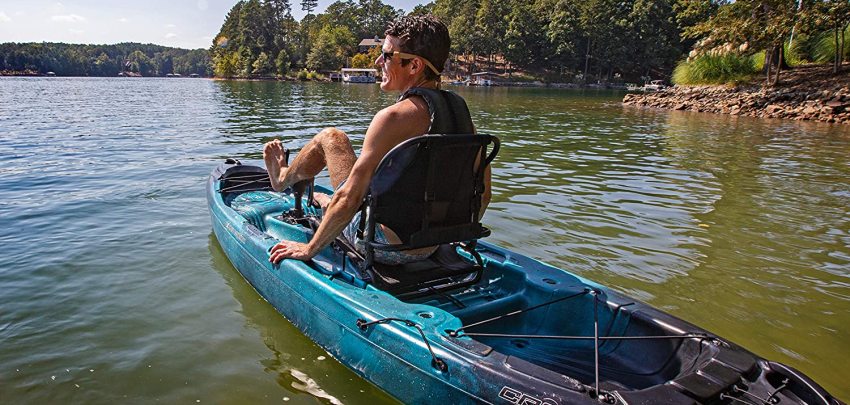
Weight
When looking for a new pedal-propelled kayak, it’s important to note whether or not you’ll be able to comfortably transport the newer ride that will almost certainly be heavier than your older paddle kayak. Purchasing a pedal kayak that’s significantly heavier than any models you’re used to will often require the use of a trailer. The added weight will also translate to a different level of performance on the water as well.
Price
Like any other gear or equipment item, a better, more efficient product will often come with a greater price tag. If you intend to make the switch from paddle kayak to a pedal system, expect to shell out a more substantial amount of money in any case. This increase in cost might drive some users away from considering a pedal-driven model, but many see it as an investment that will create a significant number of advantages over a paddle kayak.
Prop/fin protection (Shallow water and obstacles)
Some of the most highly-rated pedal kayak producers are now creating pedal systems that account for the occasional encounter with solid underwater objects that have the potential to do a great amount of damage to a delicate pedal system’s fins or propeller. Pay attention to certain models that have the ability to retract upon impact as this will almost certainly save you a great deal of frustration and cost should you hit an object that breaks or damages your system’s components.
Reverse
Not all pedal-kayaks have simple, easy to use reverse capabilities. If you anticipate fishing in areas that are tight and may find yourself in the position to travel in reverse, some kayaks have a much more efficient means of doing so than others.
Rudder
Having a quality rudder system is often the key to improving any kayak’s performance on the water. Pedal kayaks manufacturers have come a long way in producing models that offer better rudders over the last decade. Many of the top brands have designed rudders that offer the same retractable capability as the fins and propellers on some models.
It’s also important to pay attention to how the rudder is controlled from the cockpit area of the kayak. Most of the popular models have an easy-to-use knob or other type of method to control the rudder and allow the user to steer the kayak with very little resistance.
Deck Space
Having a pedal-driven kayak means that you’ll have to sacrifice deck space. For anglers who have become accustomed to enjoying a wide open deck, this can be quite an adjustment to fish from a kayak that has a large, protruding pedal system. Look out for some models that allow users to flip their pedal system upward and out of the way in order to allow them a greater amount of deck space for fishing.

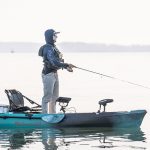
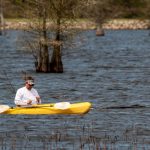

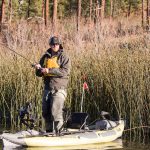
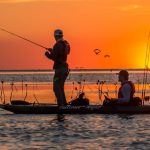
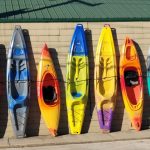
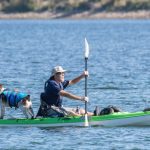
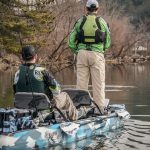

Great article. Thanks! Please keep them coming, and include verified customer reviews/complaints/compliments. Thanks!
Thank you Steven!